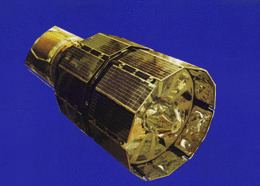Rocket Scout B Decay date 8 May 1971 Launch date 17 May 1968 Inclination 97.2° Launch mass 89 kg | Operator ESRO Launch site Vandenberg SLC-5 Inclination 97.2° Period 1.6 hours Launch mass 89 kg | |
 | ||
Similar Jupiter Ganymede Orbiter, Olympus‑1, MICROSCOPE, European Retrievable Carrier, Advanced Telescope for High E | ||
ESRO-2B or Iris (International Radiation Investigation Satellite) was a European astrophysical spin-stabilised research satellite which was launched in 1968. Operated by the European Space Research Organisation, ESRO 2B made astronomical surveys primarily in x-ray and solar particles detectors.
Contents
Spacecraft
ESRO-2B was an 89 kg (196 lb) cylindrical spacecraft with a length of 85 cm and a diameter of 76 cm. In December 1968 (approx 195 days since mission start) the on-board tape recorder suffered a mechanical failure. This effectively ended the two X-ray experiments as they did not provide any significant data return from then on.
ESRO-2B was launched on a Scout B rocket into a highly elliptical near-polar orbit on 16 May 1968 after the ESRO-2A failed to reach orbit.
Spin-stabilised, ESRO-2B had a spin rate of approximately 40 rpm and re-entered the Earths atmosphere on 8 May 1971 after completing 16,282 orbits.
Instruments
Seven instruments were carried aboard EROS 2B designed to detect high energy cosmic rays, determine the total flux of solar X-rays and to measure Van Allen belt protons and cosmic ray protons. While designed for solar observations ESRO-2B is credited with the detection of X-rays from non-solar sources.
